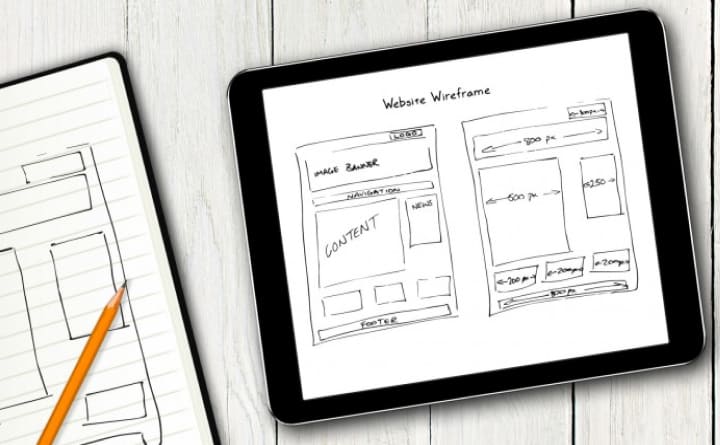Not Just Looks: How Smart Web Design Drives Engagement & Conversions
Design is an important web-production tool and a powerful marketing tool. There are many stages of work hidden behind a beautiful picture
9 June, 2023
Not Just Looks: How Smart Web Design Drives Engagement & Conversions
Design is an important Web-Production tool and a powerful marketing tool. With the increasing demand for website development, the design of WEB services received a powerful impetus to evolution. The more complex the application is and the more functionality it contains, the more difficult the work is for the designer. It is a professional technical activity of designing user interfaces for websites.
Many people think that design is just a pretty picture that catches the eye. In fact, it is not so. Each design process is unique, and there are many stages of work hidden behind a beautiful picture. The number of steps depends on the complexity of the project and on your goal.

In order for users of the service not to encounter problems of use and not go to competitors, first of all, you need to correctly analyze the target audience, study the philosophy of the company, as well as their goal. Even the color scheme and the correct font play an important role.
A competent design will help attract a client and improve the image, solve the business tasks of the site with the correct placement of accents, and also strengthen its position in the web space. It should be understood that even unique information will go unnoticed with a “template” or unsuccessful design.
Let’s take a look at the following list of steps to create a web service:
- analytics;
- creation of technical specifications;
- user flow;
- prototyping;
- creation of design layouts;
- testing;
- conclusion.
Analytics
You should start by defining your target audience and analyzing your competitors. It is important for the designer to correctly identify the target audience and its needs. Then they will be able to adapt the site to their interests and get their own benefit from this.
It is worth finding answers to the questions:
Who is your target audience? That is, who will directly use this service? It can be like existing Google analytics, marketing research, perhaps, your personal opinion and vision of the audience. The solution should be found as for which user tasks should be prioritized and which ones will be secondary. Who are your direct competitors in the field of online and offline, how are you better than them and what areas are you inferior to them in?

Creation of Technical Specifications
An extremely important step. Errors are unacceptable here, since they can appear at any stage and, as a result, throw the project far back. The terms of reference (hereinafter – TOR) prescribe the main requirements of the project, its capabilities and method of work, taking into account the analysis of the target audience and competitors, goals and strategy. In fact, the two previous stages are carried out in order to draw up a high-quality technical specification and transfer it to specialists.

Basic requirements for the terms of reference:
- Detail. Everything that a specialist has to do must be indicated in the TOR. Even if it’s a required part of the job, even if the developer has done it hundreds of times and doesn’t need a reminder. Every requirement, every aspect of the job should be spelled out.
- No inaccuracies. Any ambiguous wording or generalization has no place in terms of reference. This is an instruction that says what and how to do, but the concepts: “good”, “beautiful”, “catchy” are different for everyone.
- Understandable language. Correction: understandable for a specialist. This means that a specialist does not have to decipher and ask again what exactly they want from him.
Writing a technical assignment always causes a lot of difficulties. For these reasons, any self-respecting company helps clients in writing technical specifications.
User Flow
User flow is a visual representation of a sequence of actions that a user takes to achieve his goal. It can cover both a specific function and the entire product.
User flow allows you to look at the interaction between the user and the application through the eyes of the user.
What should a designer do? Judging by the expected result – to draw all the necessary screens so that the final product is convenient and understandable, and give it to the developers.
In general, yes. But there is an underwater part of the iceberg. There are many things hidden there that few people think about. We all love convenient and intuitive interfaces, we love when everything works logically and the result of any interaction is predictable. And for all this to be, you need to carefully work out every detail.
This is exactly what the user flow is for – it will help determine the ways for users to achieve the goal, calculate positive and negative scenarios on the chosen path of achieving the goal of our potential users. It makes it possible to understand whether all processes in the product have a logical conclusion and are built efficiently, so that the user spends a minimum of time to achieve the goal.
It is important to understand that the larger the project is and the more features it has, the more scenarios need to be worked out.
Thus, user flow helps eliminate a common mistake when creating a list of required functions and simply designing interfaces based on them. This approach is, of course, possible. But this can lead to scripts of interaction with the interface forcing the user to go through too many steps to perform simple operations.
If the scenarios are poorly worked out, clients who will use the service for the first time will constantly face the problem that they cannot find the necessary functionality, and regular users will complain about the inconvenience. And after a while, you will have to return to this stage and implement it separately, and this is a reworking of a fairly large part of the project, since after changes, the user flow needs to make changes to the service structure, to the design, and, as a result, to re-develop part of the service. And all this leads to new costs of time and money.
Prototyping

Prototyping – creating a detailed outline of a web page. It is done in order to focus on the meaning and think through the interface at a conceptual level before moving on to the graphic design. A well-designed prototype is a full-fledged skeleton of the site, on which the design can be easily “put on”.
Through prototyping, the designer:
- Saves time. A well-developed structure and arrangement of blocks in the future will help the designer not to make big changes to the finished layout, since the main part of the project will be coordinated.
- Simplifies their work. When directly creating the page design, the developer acts according to the planned stages – there is no need to think about how to correctly arrange the blocks and calculate the distance to individual elements.
- Facilitates interaction with the customer and other performers. When developing a design, a prototype is a kind of technical task, which has already been agreed with the customer and which other project participants are guided by – copywriters, marketers, and so on.
- Helps the business owner increase sales. Prototyping is not only designing individual pages of a site from a usability point of view, but also drawing up a sales strategy. The correct placement of navigation elements, banners with promotions, product cards for purchase affects the conversion of the selling site or online store.
The main purpose of prototyping is to design a user-friendly page while meeting the needs of the entrepreneur.
Creation of Design Layouts
The stage of website design development is responsible for the visual component of the resource:
- colour;
- form;
- font;
- animation.
The designer focuses on user flows, prototypes, competitors and audience description. At what time of the day the service will be used, on what device, age and characteristics of the target audience. Taking these details into account will help us make the service as successful as possible, and therefore avoid wasting your budget.
At this stage, the main task is to highlight the main and secondary user scenarios using color accents. The user should not have a single question about how to get the desired result from the service.
Benefits of Using Layout
- Identifying visual flaws in the early stages of a project.
- The ability to visually show the client design ideas.
- Understanding how the finished website will look.
- Minimizing misunderstandings between the designer and the customer.
Ideally, the layout becomes the convergence point for the opinions of the client, designer, marketer, copywriter and programmer. They should all be happy with the finished layout. In this case, the duration of work on the project will be reduced to a minimum, and you will not have to redo anything.
The design of the site layout must fully comply with the idea of the finished resource. You can create it using online services, stationary programs, or through HTML code. The main elements of the template are: style, structure, forms of communication with visitors, logo, main content, side part and footer.
The finished layout can be presented in the form of blocks with an indication of the dimensions, or as a ready-made design with the display of the page in different versions: with expanded elements, hovering over a link, an open context menu.
Testing

The designer draws the site in the Figma program, in which testing is carried out. A link is generated and passed to the focus group. By clicking on the link, the participant gets to the visually working service and can perform various actions there, checking the usability.
Thanks to the focus group, we collect data on the operation of the service and fix all the shortcomings and problems that arose during testing. This helps us to avoid problems when the service is fully launched.
Conclusion
Well, let’s highlight a few basic points that a client should know:
- Don’t be afraid to ask questions.
- Get in touch with the development team as much as possible.
- Actively participate in the creation of the project.
A serious approach to each of the stages will help the client avoid unnecessary expenses. Fewer edits – less additional costs.
Dense teamwork is the maximum result. With a little communication and effort, you already speak the same language.
Let's work together to make your project a success
Contact usLast News
Thank you!
We’ve received your contact request and will contact you soon
Something went wrong
We couldn’t receive your contact request. Please try again later.